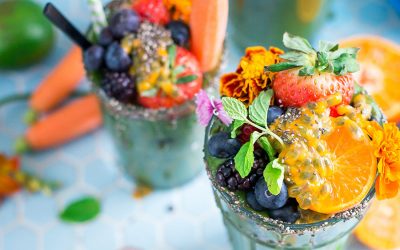Blog
Cabbage Is Trending, Here are 5 Vegan Ways To Enjoy This Versatile Vegetable
April 10, 2024
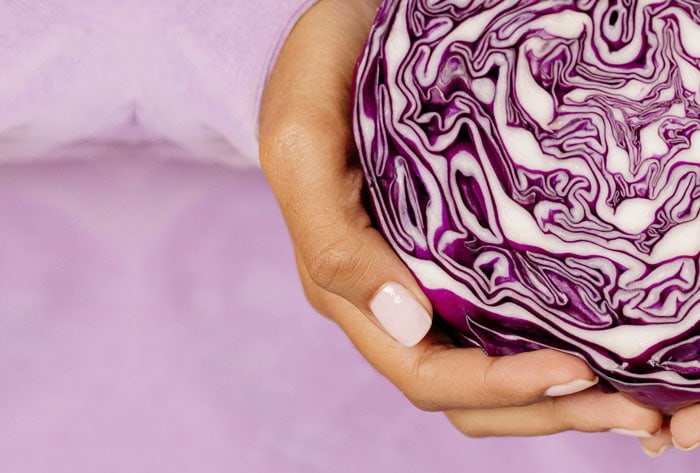
The New York Times reports cabbage is having a moment in the spotlight and trending in restaurants, so it’s the perfect time to highlight this valuable food. Cabbage, part of the cruciferous vegetable family, is extremely nutritious and high in vitamin C, fiber, vitamin K, and rich in vitamin B6 and folate. It’s also low calorie and contains powerful antioxidants including polyphenols. It may even help with digestive and heart health and protect against cancer.
There are many varieties of cabbage but the most popular are red or purple, green or white, Savoy, and Napa cabbage. Shapes vary from pointy to round, some with loose leaves, some with flat, and others with tight curly leaves. Cabbage has been enjoyed around the world for centuries but often made into meals with animal products. So what better way to honor this famous veggie than highlighting five traditional cabbage dishes that can easily be veganized into cruelty-free and sustainable alternatives? But the real question remains, is cabbage having a moment in the spotlight or has it always been there?
1. India – Patta Gobi Sabzi (Cabbage Stir Fry)
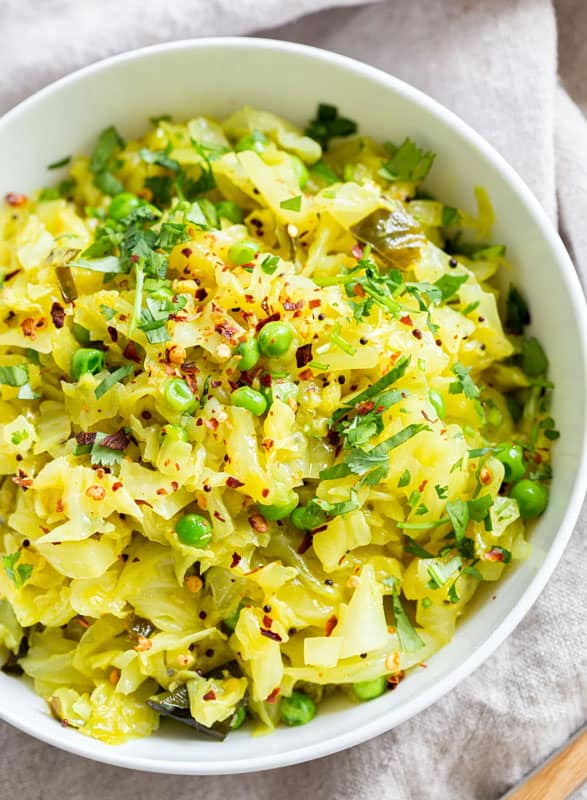
Instant Pot Indian Cabbage and Peas
Photograph: Vegan Richa
Cabbage curry is a popular food in India and considered a staple in many Indian homes. Often referred to as bandh gobhi matar or patta gobhi matar, there are several variations of this dish that is often made with peas, lentils, spices, and then stir fried. Matar means peas in Hindi and patta gobhi translates to cabbage. Richa Hingle is a talented award-winning recipe developer and cookbook author, and the vision behind popular food blog Vegan Richa. She loves sharing easy to make vegan Indian dishes such as patta gobi sabzi (cabbage vegetables). It’s made with mustard seed, garlic, split lentils, and green cabbage, referred to as cabbage subzi, which is any veggie side dish. Another fun cabbage option is instant pot Indian cabbage and peas made in a pressure cooker to save time cooking over a stove. Hingle uses turmeric and asafetida (hing), an Indian spice making the cabbage more digestible with a delicious flavor.
2. Poland / Ukraine – Holishkes (Stuffed Cabbage)
Stuffed cabbage, known in Yiddish as holishkes, originated from Eastern Europe, specifically Poland and Ukraine, with other variations found across Ashkenazi countries. Holishkes, sweet and sour cabbage leaves stuffed with rice, filling, and sauce, are a traditional dish for Sukkot, a joyful Jewish holiday celebrating the fall harvest. As explained by BBC, a version of stuffed cabbage known as “holishkes” has been part of Jewish cuisine for approximately 2,000 years.
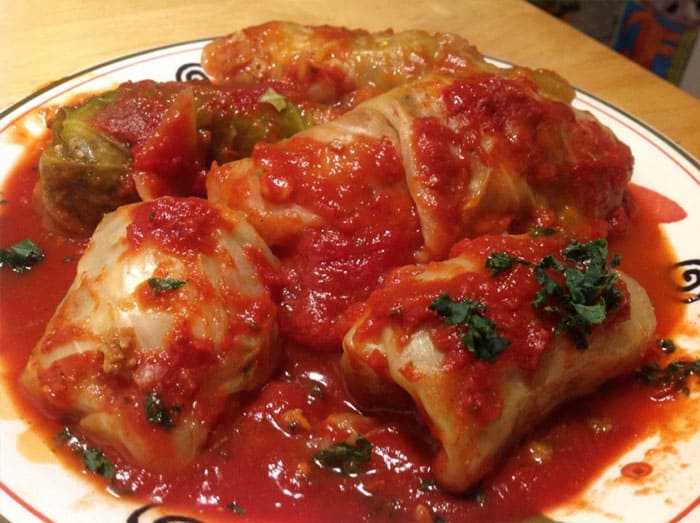
Stuff cabbage (holishkes). Photo: The “V” Word
Rhea Parsons, creator of The “V” Word, is a vegan animal advocate, cookbook author, and college professor living in New York. Her recipe for Vegan Holishkes dates back to when her mother made them when she was a kid with boiled cabbage and filling, but as a vegan she uses lentils or Beyond Meat crumbles instead of animal products. Parsons also uses egg replacer, rice, her favorite spices, and homemade sauce. Cabbage in Hebrew is pronounced k’ruv and when two holishkes are put together next to each other, they form the shape of the two Torah scrolls.
3. Japan – Okonomiyaki (Japanese Pancake)
Cabbage is the third most consumed veggie in Japan, after daikon radishes and onions. Cabbage, kyabetsu in Japanese, originally arrived from Europe. It’s been reported the first cabbages grown for eating in Hokkaido, Japan’s north island, was between 1880 and 1900. Cabbage is now consumed year-round in Japan and they are one of the world’s top cabbage producers. Ways to make this versatile food include cabbage pancakes, dumplings, shredded salad, sliced into thin strips and served with fried foods, and added to soups and stews.

Okonomiyaki pancake. Photo: Okonomi Kitchen
Okonomi Kitchen was created by talented recipe developer Lisa Kitahara, who makes plant-forward meals using seasonal ingredients with a mix of classic and modernized Japanese dishes. From Markham Ontario, Kitahara grew up with Japanese influences from her mom and loves sharing plant-based recipes with friends. Her recipe for Vegan Okonomiyaki (Osaka style savory pancake) includes yamaimo (yam), rice flour, cabbage, and tenkasu. Other ingredients she suggests adding to this popular Japanese street food are vegan cheese, corn, carrots, potatoes, and she adds her own recipe for Japanese mayonnaise (Kewpie Mayo) using cashews and tofu.
4. Korea – Kimchi (Pickled Cabbage)
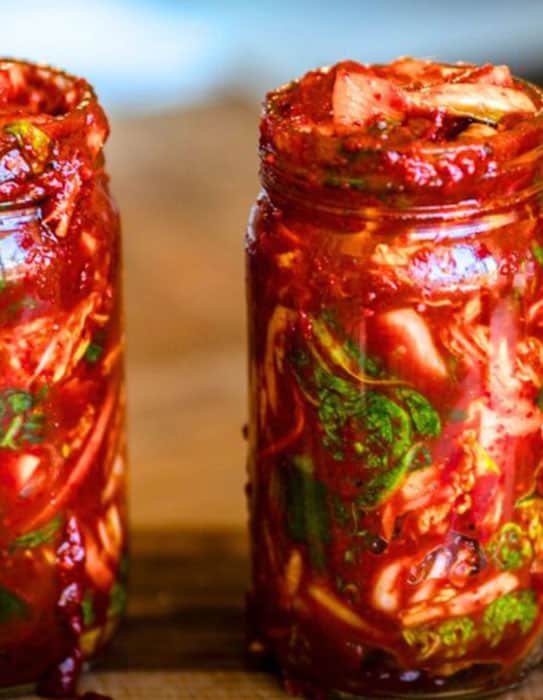
Vegan kimchi. Photo: The Korean Vegan
Napa cabbage, yangbaechu in Korean, is the most common type of cabbage used for kimchi and first introduced in the 19th century. Kimchi is made with salted/pickled and fermented vegetables and traditionally with fish sauce, but like other conventional foods, can be veganized. The talent behind The Korean Vegan is Joanne Molinaro, a New York Times best-selling author, lawyer, blogger, and recipe developer that veganizes Korean food while living in Los Angeles.
She explains kimchi as a cross between sauerkraut and bread pickles and this side dish (banchan) should be salty, sweet, tart, and crunchy. Her easy and homemade Best Vegan Kimchi uses traditional napa cabbage, gochugaru (Korean red chili flakes), sea salt, and her own vegan fish sauce and mentions you can use a strong soy sauce as a substitute as a second choice. Molinaro explains when it’s made correctly, vegan kimchi tastes indistinguishable from non-vegan kimchi and still has probiotic effects from the fermentation process. Health benefits include the promotion of positive gut health and development of good bacteria in your microflora.
5. Germany – Braised Cabbage (Red Cabbage)
Cabbage is very popular in Germany and is used in salads, soups, main dishes, side dishes, strudels, and sauerkraut. Red cabbage in particular, is common in recipes and called rotkohl or blaukraut in German, depending on the region. This trusted dish dates back many generations with each family having a variation of their own recipe.
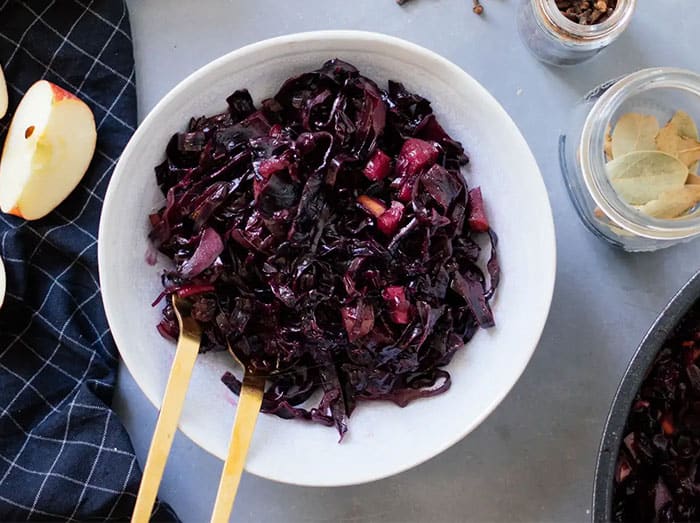
Simple red cabbage with apple. Photo: Zucker & Jagdwurst
German food bloggers Zucker & Jagdwurst from Berlin are two vegan friends, Isla and Julia, creating mouth-watering vegan recipes together, many with red cabbage. It’s a Christmas tradition to eat red cabbage and their Vegan Christmas Red Cabbage Soup with Cinnamon Croutons is a main course or appetizer. Or try their Simple Red Cabbage with Apple recipe cooked with onions or their Vegan Chopped Coleslaw with red and white cabbage including a special recipe for vegan mayo. Rotkohl, often served with German sausage or bratwurst that can easily be substituted for a plant-based version, proves once again, there are cruelty-free and sustainable vegan substitutes for every meal traditionally made with animal products.

Miriam Porter is an award-winning writer who writes about veganism, social justice issues, and eco-travel. Miriam currently lives in Toronto with her son Noah and many rescued furry friends. She is a passionate animal rights activist and speaks up for those whose voices cannot be heard.
More from the blog
Urgent Calls To Action For Earth Day
By Miriam Porter
5 Key Takeaways From The Plant Based Treaty Playbook For Sports And Athletics
By Miriam Porter
Plant Based Treaty Endorser Profile: Dr. Peter Kalmus: Sparking A Climate Revolution
By Miriam Porter


